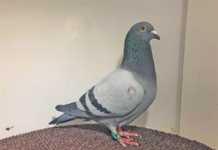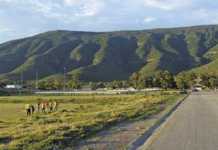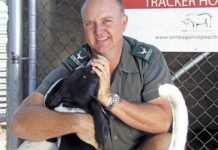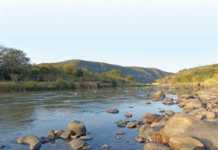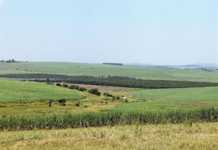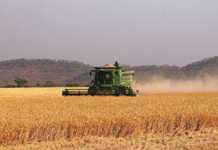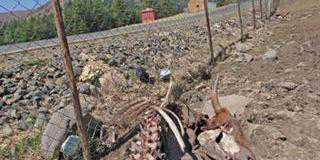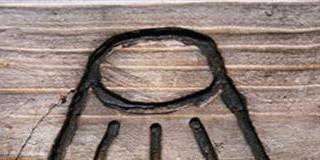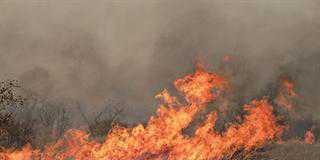What happened is, I was planning a trip and overfilled my coffee mug and stupidly placed it on an open road atlas. So of course there was a nice brown stain when I took my next sip. I looked at it with distaste and then again with the stirrings of interest, because I had accidentally put my mug down directly on top of Johannesburg, and the stain ran around the outskirts of the metropole like a giant ring road. That was a few years ago, and I’ve finally decided to make that ‘round trip’.
Day 1
Headed out on the N12 and started my circumnavigation at Argent. Stopped to use the toilet amid Cosmos, maize and twittering Red Bishops. There was a burnt-out farm building in the distance; red earth around my feet mashed into the tread-shapes of tractor tyres.

Emzevelo… Gabriel, the gate guard at Ezemvelo Nature Reserve.
Argent is said to represent the pearl… the moon… silver. Here it’s the name of a mine, which I couldn’t see. I saw only enormous hay bales, green fields, pylons and a cardboard sign that read: Flower Workers – Ladies Wanted Urgently. Since it’s common knowledge that we’re entering another recession I think of the great American writer John Steinbeck, and the pilgrimage made by the ‘dust bowlers’ of Oklahoma to California to pick fruit, and how the life awaiting them there was terribly hard, and how this strained, but did not destroy their humanity. That’s the kind of story I would like to write.
I have quiet roads before me and a new camera to experiment with. I feel adventurous. Everything is a surprise when you cross between highways. Features that are right next to the highways become great discoveries when reached from behind on district roads. Like Cultura Park, near Bronkhorstpruit. Emerging from farmland where signs advertised hengel kompetisies, I was stupefied to see, on my right, Fu Hsien St, Fo Kuang St, monumental walls and Chinese eaves, with the edges of the verges being manicured by black men in blue overalls and schoolchildren chatting up the gate-house guards in Zulu.
I took off my shoes and entered the main temple. A monk was talking on a telephone. Two women stacked incense sticks and three golden Buddhas stared out the door contentedly. Of everything, it was the feeling of having my shoes off that struck me as unreal. And it was an early affirmation of the illogical logic behind my city circumnavigation.
Outside of Bronkhorstspruit, a red road peeled off to the right, and a sign advertised a nature reserve only 20km away. It was a test, because I wasn’t ready to stop for the night. “What if it’s closed, or hopelessly uninteresting?” I worried, but took the turning.
The recent heavy rains had washed away the side of the road, exposing a bone-like plate of purple rock. Maize on either side, the road a deep ferrous red in front of me and very bad – bits of plastic bumper at one particularly deep chasm. A stuffed kudu on a brick wall came into view, then the thatched entrance to Ezemvelo Nature Reserve.
The guard introduced himself as Gabriel, “the messenger of God”. Looking into the car like a suspicious border official he spied the Thabo Mbeki biography in the passenger seat foot well. “Oh my friend,” he cried, “when you come back to this place you must bring me books like this. I don’t know about these things, this person.” I gave him a copy of Joy Addison’s Born Free, stolen from a friend on a whim. I felt bad – an outdated wildlife bestseller for a bored-stiff game reserve guard. He seemed happy with the gift, though, and waved me into the park, which the leaflet said was populated with leopard and rhino.
The road wound through grassland and turned towards a low wooded koppie, then cut through the middle of this and there, on the other side, lay the tent sites and braai facilities under tall trees. It looked very pleasant and characteristic of older South African getaways, with its putt-putt course and creosoted jungle gym. I was writing notes when a monkey leapt into car through an open window.

Delights of the road… Sunflowers on the way to Welverdiend.
The woman in the reception hut said, “Sjoe, they are naughty monkeys, these.” The chocolates and sweets laid out on a table reminded me of school retreat tuck-shops. I bought a Twicks covered in a the dandruff of the hut’s thatch, and glared at the monkeys waiting by the door. “They like to go for a Fizz Pop only,” said the receptionist.
Determined to do some game viewing, I drove down to the Wilge River at an illegal speed, wildebeest and impala flashing by. I parked by a bridge, spooked a large warthog, and watched the grey water gurgling through the bridge pipes. The sun was behind me so I took pictures of my shadow on the cement of the bridge, then remembered about the leopards.
Back at the gatehouse there was a queue of 4x4s. “Ja, this place gets quite busy on the weekends,” said Gabriel, “but, Jere, it’s boring during the week.”
I took the R25 to Verena. In between was farmland. Once you start noticing ruins in the veld it’s all you see. Also how all walkers use umbrellas to keep off the sun.
Verena is a crossroads town of 3 500 people who, for their sins, have to contend with one of the five worst police stations in the country, according to an annual Democratic Alliance document entitled The Five Worst Police Stations in the Country. Goats everywhere, and men wheeling crates of Black Label by handcart. A lone woman bundling straw on the outskirts.
The landscape opened into low hills, a near one grassed and a distant one covered in shacks, which made for a strange contrast when I collapsed the distance between them by narrowing my eyes. I came across three tall beehive huts and one incomplete one, the blue sky divided prettily by the bent wattle ribs.
I turned down a bad road, and came to a colourful building with a sign on it that said ‘conference centre’, though it was not much bigger than a roadside superette. An old man approached from some Ndebele huts, wearing khaki. He had kindly eyes and an upper lip that was a wedge of scarring. I explained my business, which was no business at all, and Paul Ngobeni smiled and took me on a tour of the badly made huts with their little tacked-on bathrooms.

P river hotel… The hotel where the music doesn’t stop until 2am.
He explained how it would have been for a well-established Ndebele family — the man in his own hut, his wife in her hut, a hut for his parents, one for his children, and a hut for additional elders. He took me up to the beehives and unexpectedly dropped to his knees and crawled into the aperture of one. I followed on my hands and knees. Standing in the gloom of the hut I asked about competition and Ngobeni explained about the well-established cultural village at nearby Klipgat, which boasts modcons like a swimming pool.
He pointed in another direction to indicate a second cultural village not too far away. The government had promised to fix a dam nearby, but Ngobeni said things do not look good “now that there is another recession coming.”
The colour of the sky intensified and I told Ngobeni it was time for me to leave. He seemed reluctant for our conversation to end. It felt good there, just off the side of the R544.
Further along I hit the dusty aisle that cuts through Klipgat, KwaMhlanga and Moloto, Joburg’s well-established dormitory townships. I was surprised by how many trees there were. The houses below them were basic, though, the toilets free-standing, the electricity cables drooping. It was getting near six and commuters were returning home from the city. Cops at the intersections were pulling people over, or just chatting to them. I went with the flow.
Somewhere to the left amid the single level structures lay the Manala Royal Kraal, the spiritual home of the Ndebele, who settled here in 1700.
Turned right at Moloto and headed north, and almost instantly the property signage carried buffalo and elephant drawings. The fences became the tall and electrified kind with those reflective tin circles so that wild animals know it’s a barrier. This went on for many kilometres, the fences only broken by stone and thatch gatehouses.
The trees made a sea, red bushwillow mainly. When I turned towards Rust de Winter it was giant monkey thorn trees leaning into each other and over rivers and bridges, which showed signs of recent flood damage. The sun became an orange eye glaring through the arching branches of the monkey thorn. The ever-shifting smell of the bush: sweet urea, sour grass, wet notes and dry notes – the olfactory equivalent of those cold and warm patches one swims through on the surface of Highveld dams.
Rust de Winter, where I had hoped to stay the night, consisted only of Tom’s Café, where the goods were all kept behind a metal grate. Some children watched me climb out of the car. They gathered around a sick looking man carrying traditional weapons. I bought a Fanta Grape and headed for Rust de Winter dam and nature reserve, passing families with their thumbs out.
It was dim when I reached the gate, which was open even though it was after the closing time. I dropped into the valley behind a twin cab towing a boat, and stopped by some portable bathrooms. Family groups had established their camps on the banks of the dam, and had their rods out and their primus stoves on. Overhearing the shrieking of girls in cold showers I decided that a night without food in my little tent listening to the jollity of others would not be progress. My map showed the road skirting the dam and exiting the other side but I was turned back by an official on his evening sweep of the roads. I followed him out of the reserve and headed for Pienaarsrivier.

Temple… Entrance to the temple near Bronkhorstspruit.
It was very dark when I crossed under the N1 and stopped at a large trucker’s area served by a bar and grocery store. In the grocery store there were two whites, one large, standing by the turnstile, and the other at the till – a small long-haired fellow with an earring and a perpetual half-smile.
“You looking for something special?” he asked me, apropos of nothing, and then said: “In any case, there’s only one hotel, and that’s the Pienaarsrivier Hotel down the road.”
Outside the hotel women in tight skirts stalked the parking lot. The receptionist was sitting on the kerb watching them. He turned out to be surprisingly tall. “Does the music carry on late?” I asked above the deafening bass emanating from somewhere inside the hotel. “All the way till two,” he replied enthusiastically.
Reluctantly, I took Room 10, directly above the disco. In the bar I talked to a teacher called Simon. He told me he encourages his students to put themselves in situations that seem desperate, because they will learn that solutions can always be found. “Think about the child whose family doesn’t have enough money for a lunch snack,” he said. “The next day that child will make a plan, because he does not want to be seen as poor.”
Simon flipped through the pages of the Mbeki biography and said how pleased he was to encounter alternative histories of the country. “I knew the old one, and now I’m learning the other ones. Unfortunately language is still my problem. I’m a Tsonga. I lived in Venda for two years and you’d think I’d learn some language but I didn’t. Others they speak Xhosa, Zulu, Pedi, but not me.”
Three of the men at the bar were wearing blue overalls. A fat woman in red sitting behind me knocked over her drink and swore. After midnight I returned to my room. The burst corners of the red stairways carpet put me in mind of dragon beards. The window above the door in my room had been covered with custard-coloured paint. I fell asleep on top of the duvet cover before the music ended.
To be continued…

